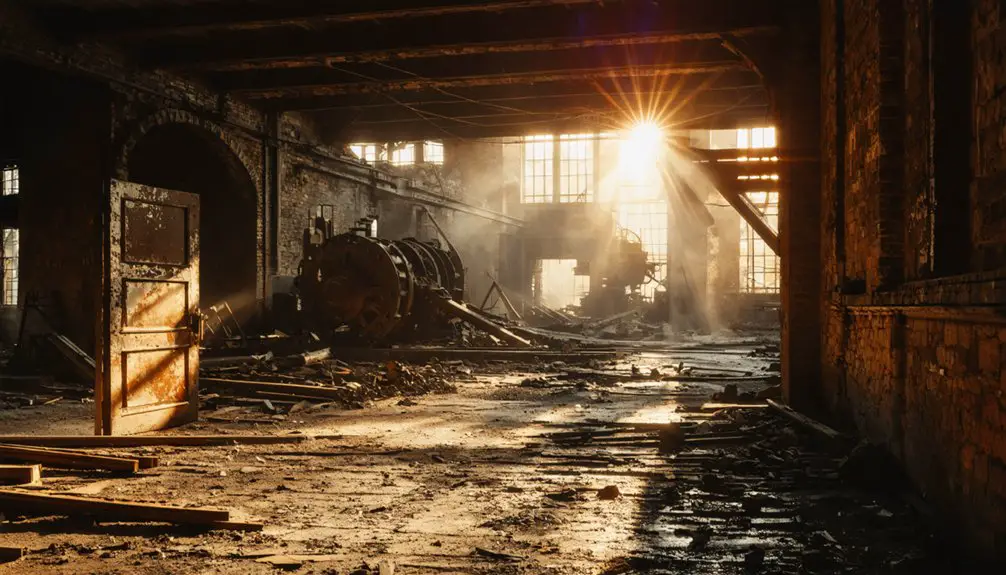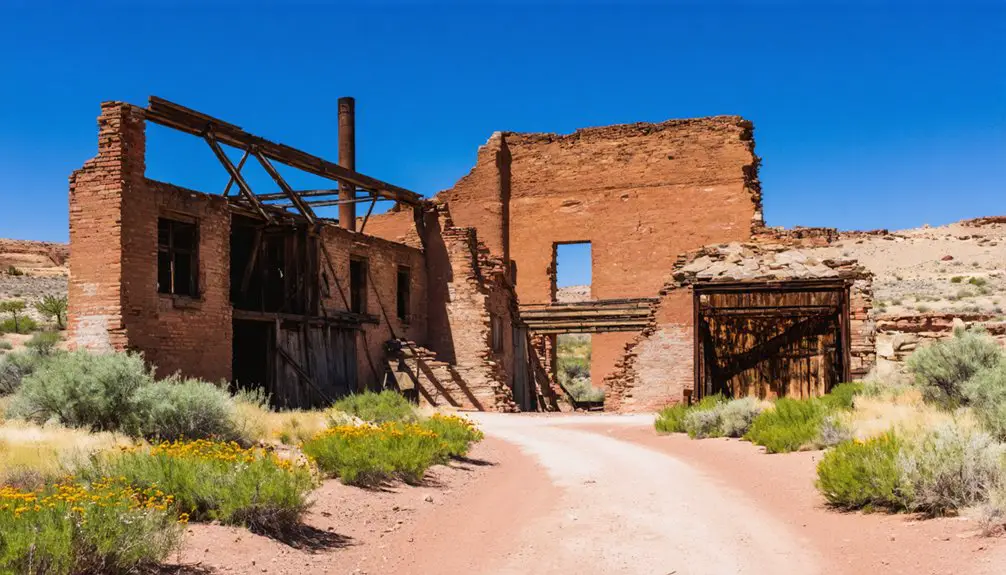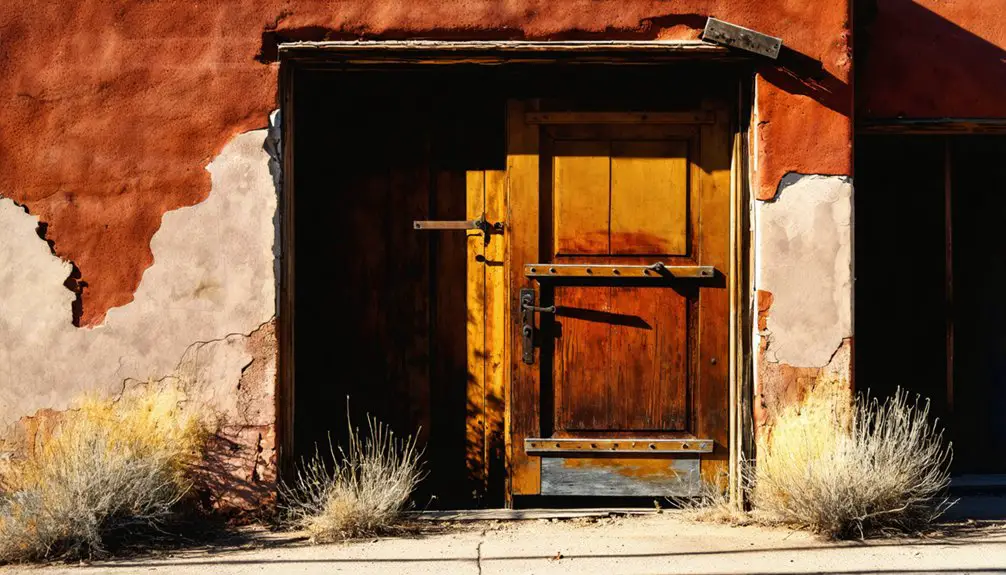You’ll find Old Iron Town‘s haunting ruins 22 miles southwest of Cedar City, Utah, where ambitious pioneers once dreamed of creating an iron production empire. Established in the 1850s, the settlement thrived briefly with daily production reaching 7 tons of iron by the 1870s. The Panic of 1873 and fierce eastern competition led to its abandonment by 1876. Today, you can explore the preserved beehive-shaped charcoal kiln and foundry remains – each crumbling structure tells a story of industrial ambition and ultimate collapse.
Key Takeaways
- Iron City was established in 1850-51 as an iron mining settlement in southwestern Utah, becoming a significant producer of iron ore.
- The town flourished during the 1870s, producing up to 7 tons of iron daily through the Great Western Iron Company.
- The Panic of 1873 and eastern competition led to economic collapse, forcing the ironworks to cease operations by 1876.
- Today, visitors can explore ruins including a preserved beehive-shaped charcoal kiln and foundry remains through self-guided walking trails.
- The ghost town is located 22 miles south of Cedar City in Dixie National Forest, accessible via Highway 56.
The Birth of Utah’s Iron Dreams
While early travelers passed through southwestern Utah without noticing its mineral wealth, the 1849 exploration party led by Parley P. Pratt changed everything when they discovered rich iron deposits in what would become Iron County. You can trace Utah’s iron dreams to this pivotal moment, when surface outcrops revealed the area’s potential for iron exploration.
Brigham Young seized this opportunity, launching an ambitious plan for Utah’s self-sufficiency. He dispatched the Iron Mission colony under George A. Smith to Parowan in winter 1850-51. One hundred twenty pioneers joined this critical mission to establish the new settlement.
These pioneers established a fort and began farming while developing early mining techniques. The location proved ideal, with abundant limestone, coal deposits, and cedar forests nearby – everything you’d need for iron smelting operations in this rugged frontier setting. The establishment of the Cedar City Iron Company in the 1850s marked the first major attempt at organized iron production, though it struggled with limited capital and labor.
Life in a 19th Century Mining Town
As iron mining operations expanded in Iron City, daily life took shape around the harsh realities of frontier industrial work.
You’d find yourself living in a company-owned home, with rent automatically stripped from your wages. Mining hardships were constant – you’d spend exhausting days underground at 9,000 feet elevation, battling altitude and brutal weather while operating water-powered drills.
The town’s social fabric reflected its diverse immigrant population, with ethnic tensions playing out in segregated neighborhoods. During the harshest winters lasting eight months, residents relied heavily on stockpiled supplies to survive the isolation.
Yet you’d find comfort in your cultural enclave, surrounded by fellow countrymen who shared your language and traditions. With nearly two dozen saloons serving the population, alcohol helped miners cope with their physical discomfort. For entertainment, you might visit the saloon or gambling hall, where alcohol helped dull the day’s aches.
Labor unions offered rare spaces where workers could unite across ethnic lines to fight for better conditions.
Peak Years of Iron Production

The early days of Iron City‘s mining operations bore little resemblance to the industrial powerhouse it would become.
The Great Western Iron Company invested heavily in production facilities and equipment to expand operations.
You’ll find that while initial iron production peaked at just 7 tons daily in the 1870s, by World War II, the region’s mines were churning out over 3 million tons annually.
Mining technology evolved dramatically, transforming the landscape with:
- Massive electric shovels carving into Iron Mountain
- Diesel trucks hauling ore across the terrain
- Multiple blast furnaces at Geneva and Ironton
- Railroad lines connecting mines to major steel plants
- Open-pit mines scattered throughout Iron County
The war years brought unprecedented growth as Iron County’s mines became essential to America’s military effort, supplying ore for shipbuilding and weapons production. Columbia Mining Company alone shipped over 1.2 million tons of ore in 1944.
The region’s transformation from modest beginnings to industrial giant stands as a reflection of American industrial might.
The Economics Behind the Collapse
If you’re looking at why Iron City failed, you’ll need to understand how the Panic of 1873 devastated the Utah Iron Mining Company’s finances just as eastern competition intensified.
The arrival of railroads in Salt Lake City meant eastern iron could now reach Utah markets more cheaply than Iron City’s local production. The company had previously maintained steady production of 5 to 7 tons of pig iron daily. The operation relied heavily on charcoal fuel from their beehive kilns to process the iron ore.
These market pressures, combined with the company’s rising production costs and limited infrastructure, made continuing operations economically impossible by 1876.
Competition From Eastern Markets
During the late 1800s, Iron City’s economic foundation crumbled under mounting pressure from eastern iron producers who’d gained significant market advantages through railroad expansion and industrial scaling.
The market dynamics shifted dramatically as eastern competition leveraged these key advantages:
- Modern rail networks that slashed transportation costs
- Large-scale production facilities achieving better economies
- Advanced industrial technology outpacing local capabilities
- Direct rail access to major market centers
- Superior capital backing, especially during the Panic of 1873
You’ll find that Iron City’s reliance on wagon transport and smaller-scale operations simply couldn’t match the cost efficiencies of eastern producers.
Their furnace output of 800 pounds every eight hours proved economically unsustainable against mass-produced eastern iron, despite having local ore deposits. The operation’s dependence on charcoal from kilns for fuel production further limited their competitive edge.
By 1876, iron production ceased completely as the town’s economic viability disappeared.
This competitive disadvantage, combined with the financial crisis, ultimately sealed Iron City’s fate.
Rising Production Costs
Beyond eastern competition’s market pressures, Iron City faced mounting internal production costs that accelerated its economic decline.
You’ll find that labor disputes and strikes disrupted operations while driving up wages, as unions demanded better compensation.
Production inefficiencies stemmed from unreliable fuel sources and frequent infrastructure damage due to flooding near Coal Creek.
The financial strain intensified as local ore reserves depleted, forcing miners to extract from more distant and challenging locations.
You couldn’t ignore the impact of new environmental regulations and higher taxes that squeezed profit margins.
The territory’s severe cash shortage complicated matters further, limiting the ability to modernize equipment or maintain competitive operations.
Iron City’s producers found themselves caught in a spiral of rising costs that proved insurmountable.
Financial Panic Impact
The devastating Panic of 1873 struck Iron City at its most vulnerable moment, releasing a chain of economic catastrophes that would seal the town’s fate.
You’ll find that this nationwide financial crisis brutally exposed the town’s weaknesses, leading to:
- Banks collapsing and credit vanishing when the ironworks needed it most
- Iron prices plummeting as national railroad speculation went bust
- Workers fleeing as wages dried up and community tensions rose
- Stores and schools shuttering amid widespread financial distress
- Critical infrastructure deteriorating without maintenance funds
The panic’s grip tightened relentlessly on Iron City’s single-industry economy.
Without transportation infrastructure to reach broader markets and faced with plunging iron demand, the town’s ironworks struggled until 1876.
When the furnaces finally went cold, the community disbanded, leaving behind only ruins of its industrial dreams.
What Remains Today: A Walking Tour
As you explore Iron City’s remnants today, you’ll encounter the distinctive beehive-shaped charcoal kiln, foundry ruins, and scattered chimney foundations that tell the story of this once-bustling industrial site.
The self-guided walking trails, stretching roughly ¼ mile each, lead you past the impressive kiln structure and a pioneer cabin ruin, connecting the town’s industrial and residential histories.
You can follow interpretive plaques along the trails that detail the ironworks’ operations, while the surrounding Dixie National Forest provides a striking backdrop to these 19th-century ruins.
Key Landmarks and Ruins
While exploring Iron City’s historic grounds today, you’ll encounter several well-preserved industrial and residential ruins that offer fascinating glimpses into Utah’s pioneer iron industry.
The landmark features tell a compelling story of this once-bustling mining settlement, with each ruin significance highlighting different aspects of frontier life and industrial innovation.
- The distinctive beehive-shaped charcoal kiln stands as the site’s primary landmark, remarkably intact after 150 years.
- Glass furnace chimney remnants showcase the town’s diverse manufacturing capabilities.
- An arastra furnace, used for grinding sand for casting molds, provides insight into iron production methods.
- Pioneer cabin ruins along the interpretive trail reflect daily frontier life.
- The old foundry’s foundations and chimney ruins mark where iron smelting operations once thrived.
Exploring the Charcoal Kiln
Standing as Iron City’s most impressive remnant, the beehive-shaped charcoal kiln offers visitors an intimate look at 19th-century industrial ingenuity.
You’ll find this well-preserved structure along Iron Town Road, where it once produced essential fuel for the town’s iron smelting operations. The kiln’s sophisticated design, with its adjustable air holes, showcases the advanced charcoal techniques used to convert juniper and pinyon wood into high-quality fuel.
Today, you can explore this historic site via a short public trail managed by Frontier Homestead State Park Museum.
Despite challenges in kiln maintenance over the years, it’s survived while its companion kiln succumbed to weather and vandalism. The site includes interpretive signage and a picnic pavilion, allowing you to immerse yourself in Utah’s pioneering industrial heritage.
Historic Mining Trail Network
Today’s visitors can explore Iron City’s rich mining heritage along a fascinating 2-mile trail network that follows the original routes used by 19th-century miners.
The well-preserved paths wind through pinyon-juniper woodland, connecting key industrial sites where mining techniques of the past come alive through interpretive signage.
As you traverse the rugged terrain, you’ll discover:
- Towering foundry chimney standing as a symbol of Iron City’s industrial might
- Intact beehive charcoal ovens showcasing 19th-century fuel production methods
- Ancient arastra grinding mill remains near trail edges
- Impressive blast furnace foundations revealing early smelting operations
- Protected ruins fenced by Sons of Utah Pioneers
Trail conservation efforts maintain these historic treasures while protecting the surrounding Dixie National Forest environment, offering you an authentic glimpse into Utah’s pioneering industrial past.
Historical Legacy and Preservation
Because of its status as Utah’s first planned iron mining settlement, Old Iron Town represents an essential chapter in the state’s industrial heritage.
As the pioneer of Utah’s iron industry, Old Iron Town stands as a testament to the state’s early industrial ambitions.
You’ll find remnants of community resilience in the preserved structures, including two iconic beehive-shaped charcoal ovens and foundry ruins that once produced up to 7 tons of pig iron daily.
Today, you can explore this reflection of pioneer ingenuity through the Frontier Homestead State Park Museum’s management.
The site’s marked trails and interpretive plaques guide you through the industrial complex, where you’ll discover the foundations of pioneer cabins, blacksmith shop remains, and grinding stones.
While the settlement’s economic viability ultimately succumbed to eastern competition and regulatory pressures, its preserved ruins continue to educate visitors about southern Utah’s pioneering industrial spirit.
Planning Your Visit to Old Iron Town

Planning a visit to Old Iron Town requires careful preparation due to its remote location in Dixie National Forest, 22 miles south of Cedar City.
You’ll need to maneuver access routes via Highway 56 and Old Iron Town Road, so bring detailed maps or GPS as signage is limited.
For a successful self-guided exploration, you’ll want to pack:
- Plenty of water and food – there aren’t any facilities on-site
- Sturdy hiking boots for traversing uneven terrain
- Weather-appropriate clothing for variable forest conditions
- Camera to capture the historic blast furnaces and kilns
- Basic first-aid supplies and emergency gear
Visitor preparation should focus on self-sufficiency, as you won’t find restrooms, water sources, or visitor centers at the site.
Plan your trip during spring through fall to avoid harsh winter conditions.
Frequently Asked Questions
Were Any Notable Outlaws or Wild West Figures Connected to Iron City?
You won’t find any outlaw legends or wild west figures tied to this industrial settlement – historical records show no famous outlaws visited here, despite tales of rustling in nearby ghost towns.
What Happened to the Residents After the Town Was Abandoned?
After the town’s dramatic collapse, you’d find the residents scattering like tumbleweeds to Cedar City and Parowan. Most families made their way to these established towns, forever leaving behind Iron City’s once-promising legacy.
Are There Any Reported Ghost Sightings or Supernatural Occurrences at Old Iron?
You won’t find documented ghostly encounters or supernatural legends at Old Iron Town. Historical records, visitor accounts, and local tourism materials focus purely on the site’s industrial and pioneer heritage.
Did Native American Tribes Interact With the Iron City Settlement?
Like shadows in the desert wind, you’ll find little evidence of cultural exchange or trade relationships between Iron City settlers and Native tribes during the settlement’s brief 1868-1876 existence.
What Tools and Personal Artifacts Have Archaeologists Recovered From the Site?
You’ll find archaeological findings like mining equipment, puddle furnaces, and Chinese porcelain bowls. Historical artifacts include Chinese currency, peanut shells, and iron-working tools from the pattern house remains.
References
- https://www.youtube.com/watch?v=EWte1RfhQMo
- https://435locals.com/ghost-town-near-zion-old-iron-town/
- https://www.tripadvisor.com/Attraction_Review-g60765-d10376164-Reviews-Old_Iron_Town-Cedar_City_Utah.html
- https://en.wikipedia.org/wiki/Old_Irontown
- https://www.youtube.com/watch?v=HEzvZbKl3y8
- https://www.mininghistoryassociation.org/Journal/MHJ-v28-2021-Grubb Review Jones_Iron Mining and Manufacturing in Utah.pdf
- https://utahrails.net/mining/iron-mountain.php
- https://www.uen.org/utah_history_encyclopedia/i/IRON_MISSION.shtml
- https://historytogo.utah.gov/mining/
- https://utahrails.net/mining/dup-mining.php



